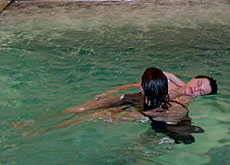A dip into the history of bathing

The Swiss are rediscovering a love of public baths thanks to changes in lifestyle and the current heatwave.
Thermal baths, which were at the height of their popularity in medieval times, once had a reputation for hedonism and promiscuity.
But today, bathing is once again in fashion for those concerned with keeping fit and healthy.
In ancient and medieval times, Europeans went bathing at places famous for the properties of their water such as hot springs.
Hot springs
The thermal baths at Baden, Yverdon and St Moritz in what is now Switzerland were already well known in antiquity and were added to by the hot springs at Leukerbad, Pfäfers, Scuol and Alvaneu in the medieval period.
Baden was particularly popular in ancient times and was known as the Aquae helveticae – the Swiss waters.
In the 15th century, baths were not just used for curing ailments, they were also places to socialise. In fact, they acquired quite a racy reputation as places of nudity and promiscuity.
But the emergence of the Reformation and Counterreformation in Europe brought in a more sober climate of puritan morals and prudishness that frowned upon the excesses of bathers.
Rediscovery
Bathing was rediscovered in the 19th century, helped by the boom in tourism and the fashion for taking the waters as a cure for illnesses.
Around 1860, Bern had 73 baths and there were also establishments in Geneva and Lugano.
The 19th century also saw the appearance of the first non-thermal baths in cities, created mainly for reasons of hygiene or to encourage swimming.
These tended to be fenced off places in lakes or rivers, far away from the public gaze, such as the first public baths in Switzerland – the Marzili baths in Bern, which opened in 1828.
Outdoor bathing in lakes and rivers for relaxation and to be closer to nature became popular at the turn of the century and many public baths were modernised in the 1920s and 1930s.
Bathing morals
In earlier times men and women used the same baths. But this changed over the centuries and there was generally a strict separation of the sexes at public baths until the mid 20th century.
But after the Second World War, summertime bathing outdoors or at public paths became more and more common.
This was prompted by the rise in paid holidays and people having more spare time, as well as the popularity of sport and mass tourism. A whole bathing industry sprang up making costumes, accessories and cosmetics and was aggressively marketed.
Nowadays, in Zurich and Geneva there is a fashion for mixing swimming and lifestyle, with baths being transformed into bars, restaurants or discos in the evenings.
Thermal baths are also undergoing a renaissance thanks to the wellness trend currently sweeping through Europe, which offers fitness and beauty treatments for today’s stressed society.
swissinfo, Marco Marcacci (translation: Isobel Johnson)
In medieval times, public baths had the reputation for hedonism and promiscuity but this began to change as the Reformation took hold.
Bathing regained popularity in the 19th century and public baths were built.
Today, bathing is in fashion thanks to the wellness and fitness trends. Swimming pools are also used for recreation.

In compliance with the JTI standards
More: SWI swissinfo.ch certified by the Journalism Trust Initiative












You can find an overview of ongoing debates with our journalists here . Please join us!
If you want to start a conversation about a topic raised in this article or want to report factual errors, email us at english@swissinfo.ch.